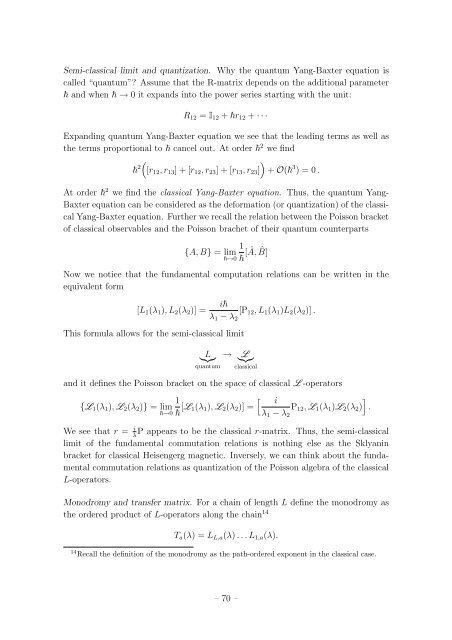Student Seminar: Classical and Quantum Integrable Systems
Student Seminar: Classical and Quantum Integrable Systems
Student Seminar: Classical and Quantum Integrable Systems
You also want an ePaper? Increase the reach of your titles
YUMPU automatically turns print PDFs into web optimized ePapers that Google loves.
Semi-classical limit <strong>and</strong> quantization. Why the quantum Yang-Baxter equation is<br />
called “quantum”? Assume that the R-matrix depends on the additional parameter<br />
<strong>and</strong> when → 0 it exp<strong>and</strong>s into the power series starting with the unit:<br />
R 12 = I 12 + r 12 + · · ·<br />
Exp<strong>and</strong>ing quantum Yang-Baxter equation we see that the leading terms as well as<br />
the terms proportional to cancel out. At order 2 we find<br />
)<br />
<br />
([r 2 12 , r 13 ] + [r 12 , r 23 ] + [r 13 , r 23 ] + O( 3 ) = 0 .<br />
At order 2 we find the classical Yang-Baxter equation. Thus, the quantum Yang-<br />
Baxter equation can be considered as the deformation (or quantization) of the classical<br />
Yang-Baxter equation. Further we recall the relation between the Poisson bracket<br />
of classical observables <strong>and</strong> the Poisson brachet of their quantum counterparts<br />
{A, B} = lim [Â, ˆB]<br />
<br />
→0<br />
1<br />
Now we notice that the fundamental computation relations can be written in the<br />
equivalent form<br />
[L 1 (λ 1 ), L 2 (λ 2 )] = i<br />
λ 1 − λ 2<br />
[P 12 , L 1 (λ 1 )L 2 (λ 2 )] .<br />
This formula allows for the semi-classical limit<br />
}{{} L → }{{} L<br />
quantum classical<br />
<strong>and</strong> it defines the Poisson bracket on the space of classical L -operators<br />
1<br />
[<br />
{L 1 (λ 1 ), L 2 (λ 2 )} = lim<br />
→0 [L i<br />
]<br />
1(λ 1 ), L 2 (λ 2 )] = P 12 , L 1 (λ 1 )L 2 (λ 2 ) .<br />
λ 1 − λ 2<br />
We see that r = i P appears to be the classical r-matrix. Thus, the semi-classical<br />
λ<br />
limit of the fundamental commutation relations is nothing else as the Sklyanin<br />
bracket for classical Heisengerg magnetic. Inversely, we can think about the fundamental<br />
commutation relations as quantization of the Poisson algebra of the classical<br />
L-operators.<br />
Monodromy <strong>and</strong> transfer matrix. For a chain of length L define the monodromy as<br />
the ordered product of L-operators along the chain 14<br />
T a (λ) = L L,a (λ) . . . L 1,a (λ).<br />
14 Recall the definition of the monodromy as the path-ordered exponent in the classical case.<br />
– 70 –

















